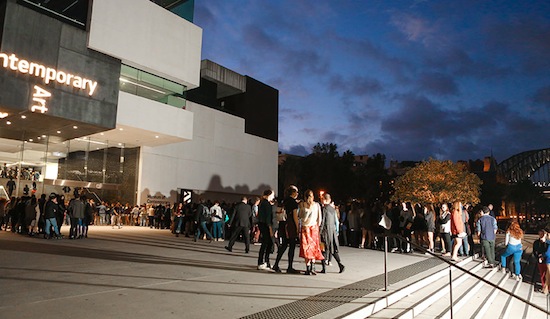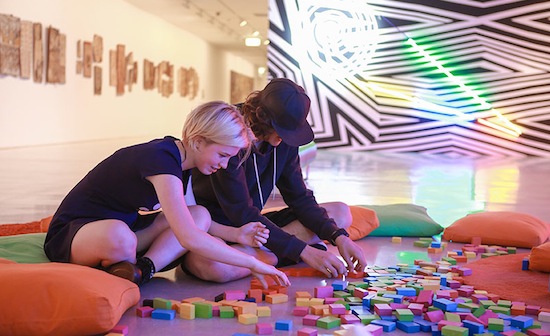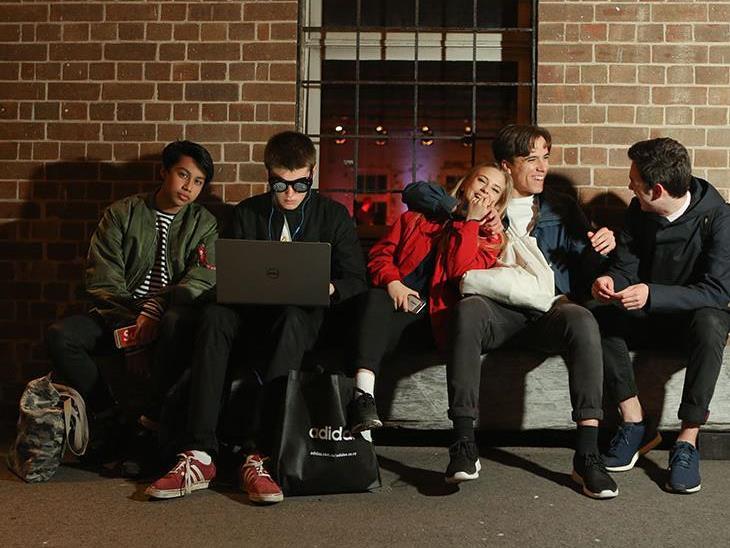Genext goes to Underbelly Arts Festival on Cockatoo Island, 31 July 2015, photograph: Maja Baska; courtesy MCA
Cultural organisations have come to recognise the value of youth engagement through their well-established education and school programs. However, the term “youth” itself elicits confusion.
Definitions of youth engagement vary dramatically. While ‘youth’ broadly refers to the 14 – 26 year age bracket, engagement is open to interpretation.
Fraser Corfield, Artistic Director Australia Theatre for Young People (ATYP), has been advocating for young people in theatre for more than 15 years. He believes that youth engagement is not one thing. ‘It is not a simple process that you need to roll out for everything you do. You are able to completely tailor it based on what you need.’
One of the greatest problems we continue to face across the sector is communicating quality when young people are in, or have created, a creative production or event, explained Corfield.
‘If young people have driven the art then we tend to assess it will not be very good. It is a preconception that we are dedicated to challenging,’ he said.
Today, many theatres and galleries are lending their ear to young people to create better programming through advisory and steering committees. They are proving successful in chipping down misconceptions, and to broadening how we think about audiences as arts organisations.
But as with the engagement of any committee, how you keep them motivated and how you ensure that relationship is genuine are key to their success. It was the topic tackled at a recent SAMAG seminar for arts professionals in Sydney this week, and the outcome was both instructive and optimistic.
Keeping it authentic
‘Authenticity is so important. Do what you say you will do and don’t bullshit to them – it is so obvious to them when you are not being yourself or not listening to them.’ It was heartfelt advice from Belinda Sculley, Young Creatives Coordinator at Sydney’s Museum of Contemporary Art Australia (MCA).
She is entrusted with the job of developing and implementing informal creative learning projects and experiences for young people, part of which is Genext, a committee-driven program of events that taps into specific exhibition and drives over 700 attendees per event with an age range of 12-18 years. Importantly, youth produce the entire event.
Sculley talks daily online with her Genext committee. ‘I don’t do anything without consulting them first. They know what they want and they are going to tell me what is the good thing to do.’
Corfield agreed, adding that key to authenticity was responsibility. ‘You have to be able to take a punt on something they recommend, to demonstrate to them how they affect change. You have to be prepared to hand over some responsibility.
‘If you can’t demonstrate how their feedback is affecting change in your organisation then there is no point having them,’ Corfield added.
Sculley pushed the authenticity debate further: ‘If I am running the (youth program) as a 36 year old it is not going to work – a program for young people run by an old person – its weird!’
Sculley is right. Leaving the session walking behind three young males the comment was overheard: ‘They say, “How do you ask a question?” Just talk to them like you would anyone else.’
Too often as adults we overcompensate our enthusiasm and it becomes disingenuous or forced.

Source: ATYP
Setting up a steering committee
Corfield made the point that cultural organisations have different youth committees for different reasons and for different types of engagement. These need to be clear first and up-front, both within the organisation and your recruitment process.
‘If you are thinking about establishing a committee you need to get the buy-in of your board,’ added Andrew Johnson. ‘The really big thing is that people often engage with advisory committees and do a whole lot of work but feel they are giving their opinion on something that is already decided.’
Johnson heads up the recently formed independent office, NSW Advocate for Children and Young People to advice Government. Its job is to ensure that the voices of young people are included in policy making and heard in parliament. And he assured us government is listening.
‘The arts and culture community have always done youth participation well and have always been at the forefront. I think the Government is starting to understand that it can be possible to talk to young people. We have learnt by your best practice,’ he said.
Setting up their advisory committee they spoke to 4,000 youth. He said that it was important to get as much diversity of voices when setting up a committee.
It was a point echoed by Sculley. ‘When I was first in the role and recruiting I picked out all the best applications – selected the best and the brightest and had an entire team of leaders. It was just awful. It wasn’t harmonious and we got little done. It was a massive life lesson. Understanding that you need different people to play different roles in a group is really important.’
‘Setting up an environment where every voice is heard is key to the success of the committee,’ Corfield added, but warned, ‘It is amazing how quickly a hierarchy can establish within your own steering committee – a 22-year old’s voice is more perceived authentic than an 18 year old, over 16, over 13 year old, as they have more life experience.’
Johnson extended that warning: ‘Often we get caught in the trap of trying to please young people. If you are an adult in that process the biggest thing is not talking. The best way to help is to shut up and wait – it takes practice.
‘Ask questions that are open ended and don’t worry if there is silence. Often young people aren’t asked for their opinion, so they need time to think about this. We don’t allow young people enough thinking time. Again it is about being genuine.’
The reasons for youth wanting to be more engaged were also varied. Johnson said that their research found that this generation is more altruistic and more community minded.
Sculley added that it can also be a safe place to find themselves, a path to professional development or to just meet people.
‘There are not many arenas for young people “to try” today. It is embedded in them from schools and parents that they have to succeed, that they have to win. We can offer a safe space where they can dare to risk, dare to fail.’
Sculley said that key to the success of any steering committee, however, is having the time to put into the growth of the relationship with young people she is working with so that genuine trust evolves and mutual respect. ‘That we keep it real,’ she emphasised.
The MCA has had the luxury of funding from the Balnaves Foundation for eleven years, which has allowed planning, risk and the development of programs.

Genext, 19 April 2015, photograph: Maja Baska, courtesy MCA
Finding them – these youth!
‘I think people have the assumption that the bright and shiny people are the only people who want to get engaged,’ said Johnson.
‘You have to go out of your way and say that this is an opportunity for everyone. When I went out to them the common response was, “It’s not me, I am not smart, I’m not top of the class. They inavertedly place limits on who it can be,’ reported Johnson.
He said that the number one factor why they engage is to meet people.
It a two way street. Sculley said they had had great success with their “Genext cart” – a tricycle mounted with a massive stereo and amps, fold-out drawers filled with art goodies and a badging machine on it. ‘We take that on off-site adventures, to other festivals and events and talk to them. We physically go out and get our audiences.’
She recalled a marketing term she had heard, “on their terms on their turf in a way they understand”. ‘It sounds patronising, but it is for adults’ – language to help them shift their frame of thinking.
Corfield reminded that as organisations looking for an outcome, you need to ask yourself some serious questions first: ‘Is this an advisory group to help you with your plan for something, or is it an advisory group to be representative? Your desired outcomes will affect who you chose.’
A young adult attending the talk, and who was involved in the MCA program, added to the conversation: ‘Personally I wanted to set myself up to have some experience to get in the art world later in life so I thought it was a good idea to get in now and make connections in a professional way. I was excited to find something outside of school that would help me learn that was “if you fail your HSC you wont be homeless and can never learn again.’
Sculley said that the recruiting process is grueling. She interviewed 70 applicants for 34 positions this year, each having completing a five-page application.
She said: ‘Don’t ask them what their skills are, but ask them what they think they can bring. Ask open ended question like, “Why is engagement in the art is important for young people?” and “Why is that important to you?”’
Johnson said that, ‘Getting the word out is easier than people think. You have to think about where children are, local groups for example and say to them here is an opportunity. And for those doing it tough, they are often engaged with lots of services – the Salvation Army and Mission Australia.’
It was a point reiterated by Corfield: ‘If you want diversity or to provide access to marginalised voices then you have to actively approach them and convince them to be a part.’
Youth as the gold path to new audiences
So you have this great idea to be youth engaged, and then you go and find your committee – so what is next? Does your audience suddenly blossom?
‘Be wary of setting up a youth steering committee in the hope that they are going to market your organisation to young people. There are a lot of organisations that seem to believe the focus of their youth committee is to, “tell all your friends so we can fill the theatre”, said Corfield.
‘That is not the point of your steering committee. They should not be your marketing team. You want them to believe in the organisation, to make them central to your organisation and then they will passionately speak about what you do,’ he continued, acknowledging the best form of marketing was word of mouth.
If it is just about marketing then call them a P.R committee and you will attract people who are interested in that he added.
Johnson added the very lucid point: ‘If someone is engaging in a youth advisory committee and you want new audience, you have to understand that the people around the table are already engaged. It is the non-engaged you are looking for.’
He added, ‘Train them to go out and talk to young people and do the consultations.’

Genext, 6 December 2015, featured artwork: Brook Andrew, Loop. A Model of how the world operates (detail), 2008, installation view, MCA Collection; image courtesy the artist and Museum of Contemporary Art Australia © the artist, photograph: Maja Baska
Youth want digital … yeah right?
Johnson said that contact and engage is vital at a youth level. ‘Policy makers assume that young people do it all by digital and have access to all this stuff. You need digital platforms to connect face-to-face, but it this connection that matters.’
You have to get out of the office if you are serious about connecting.
ATYP is a national organisation, managing a committee across a broad geographic footprint can be challenging.
‘From my experience you have to bring everyone together first for a few days to build relationships and trust, and then everyone can go home and keep conversation going,’ said Corfield, but added, ‘Every time we have tried to set up nationally online it has failed, or at least slowly dissipates. You need to bring then together once a year at least.’
And that costs money and takes another whole level of commitment.
The panel suggested that as a touring company you could use those locations to start building groups of conversations, or partner with other theatres and schools regionally to extend that voice.
However, it was unanimous that this can’t be done half-heartedly. Committing to a youth engagement program or appointing a youth steering committee of your organisation is a serious investment in the future of your organisation, and it requires buy-in at every level.
Sculley concluded definitively: ‘Those key factors – respect, trust, transparency, candor – without them its just not going to work.’
The Next Gen: Youth engagement in the arts was presented by SAMAG. Its next discussion will be held on 18 May, titled The Future of Audience Research.





